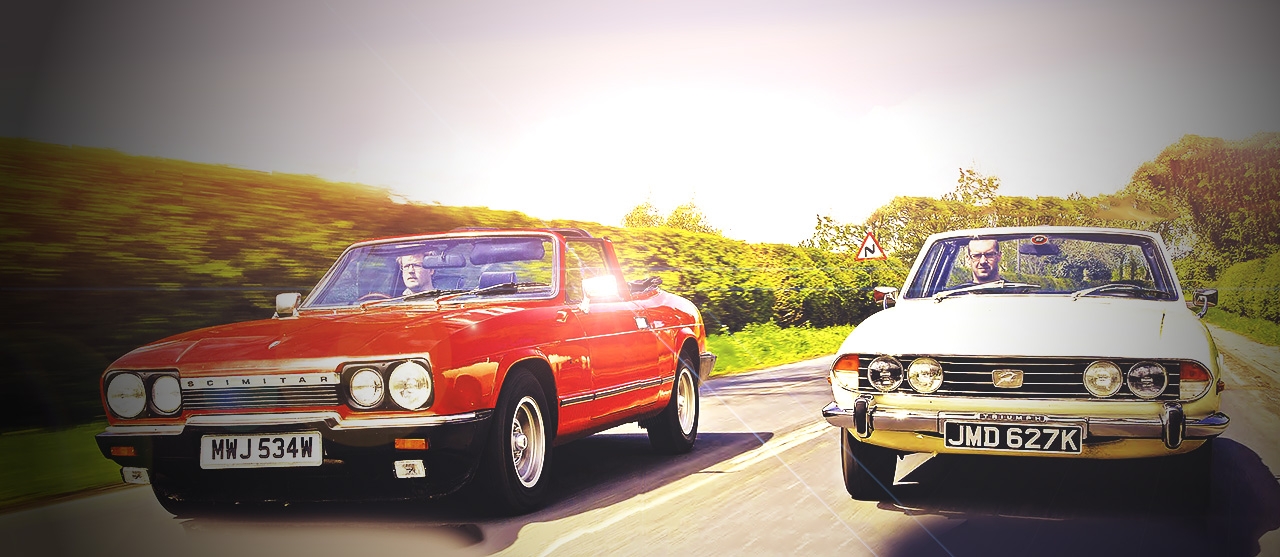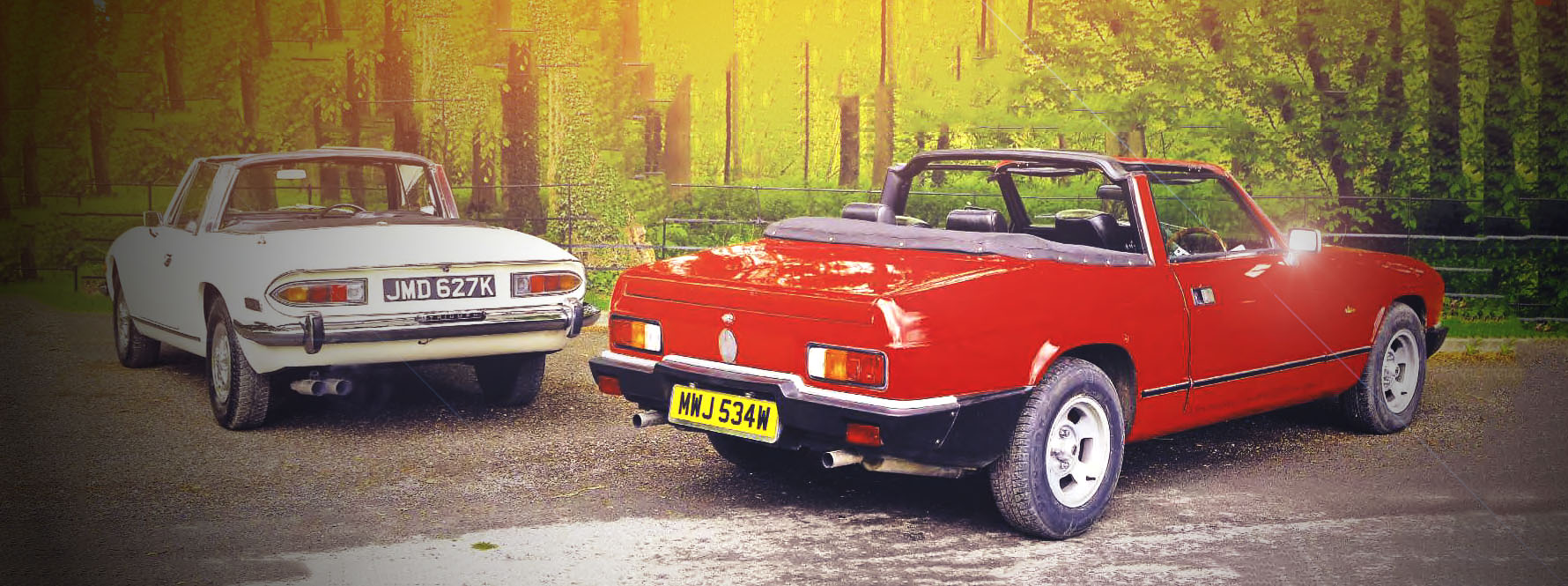
Epic battles Reliant Scimitar GTC vs Triumph Stag – “t” for two. Can the Tamworth T-bar beat Canley’s classic convertible? Sam Skelton decides. It was easy being a convertible fan in the 1950s and 1960s. You started out with a small sports car like the MG Midget, graduated to a big burbly Healey or TR, and then, when marriage and 2.4 children beckoned, you were spoiled for choice by Super Minxes, Vitesses, Minors – you name it.
Family-friendly four-seat frolics in the sun could be yours. However, that last stage became harder as the 1960s became the ‘70s. With the exception of Crayford-style conversions, the only common fourseater convertible was the Triumph Stag. When that left production in 1977 there was a gap in the market, which Reliant filled with its GTC three years later.
Fast-forward 30 years and it’s clear which the market prefers. With nice Stags fetching well into five figures and the very best GTCs around the £6500- 7000 mark, it’s evident that classic car fans prefer the traditional charm of the Triumph to the late ‘70s stance of the Reliant. But is this a fair judgment? Is the Scimitar GTC more than a wannabe Stag or is it just a plastic copycat? Read on – you may be surprised.

GTC: SENSESWORKING OVERTIME
If the Stag is an attempt to sex-up a saloon car base, then the GTC is a softened and lengthened sports car. The induction roar of that Cologne is more 1970s TVR than it is Granada, and that’s pretty much how the whole car feels. There’s that small British sports car company feeling of determination and chassis engineering over cosmetic trinketry. To that end, the black plastic of the cockpit is functional, but it’s inoffensive and serves its purpose. The prominent centre console is perhaps a little too wide, but that only supports the sensation that the driver is in a cockpit, enveloped by instruments and controls.
The pedals are offset but feel well-placed, as does the gear lever with its long and notchy throw. We also like the location of the overdrive – an extended switch well within reach of your right hand while on the wheel. But you feel almost as if you’re shoved up against the door, despite the fact it’s a nice wide cabin. Moving the seats three inches inboard would make all the difference – and the space to do so is there. The seats themselves are excellent, though.
They compensate for the sporting ride and make the GTC a comfortable long-distance companion. The button-backed velour screams late 1970s, though in here our test Scimitar we’re spared the vivid blues and browns of earlier examples. The power steering also helps – it’s light without being numb. The car feels planted on just about any surface, but if you feel mischievous you can quite easily have a little sideways fun with it. It’s meaty, muscular and masculine to the core.
STAGGERING COMPROMISE
If the Stag’s sensual curves lead you to expect a sporting driving experience, you’re in for a shock. Because the Stag isn’t a driver’s car – from behind the wheel, it feels very similar to its 2000 saloon sibling, despite the attractive walnut dash.
You sit high for a GT, with a big glass area and a roomy cabin. The seats are not badly shaped, but there’s not quite enough bolstering to stop you sliding about when you drive spiritedly The steering is nicely weighted, but the power assistance robs it of much of its feel. You can press on in the corners, but it’s not always easy to gauge exactly what the wheels are doing through the steering. The thin steering wheel doesn’t really inspire, either.
The suspension is tuned more for ride than for handling. We’ve driven large saloons of the era that absorb bumps less effectively; a surprise when you remember that the T-bar is not there just to appease the American safety market but to strengthen what, by all accounts, was a very floppy bodyshell. But then, that compliance makes it a far more effective car in which to cover ground than any sports car – it’s only when you drive a Stag hard over rough roads that you appreciate just how capable it is as a package.
But regardless of the surface, knock it down a cog and nail it, and the dynamic shortcomings are a distant memory. That mellifluous V8 bellow is so much more musical than most – with the roof down, sunglasses on and Tony Christie on the eight-track it comes close to being the ultimate open-air driving experience.
TRIUMPH STAG
Turin showcar to mature V8 The Stag story began in 1965, when Michelotti requested a Triumph 2000 as the basis of a show car for that year’s Turin Motor Show. Triumph technical chief Harry Webster agreed, on the understanding that if he liked the result it would not be shown and Standard-Triumph would have first refusal on the design. Webster fell in love with the show car and the Stag was born. Incidentally, Stag was originally the model’s internal code name, but surveys failed to yield a more appropriate monicker. The original plan to use the 2000’s straight-six was canned in favour of a V8 powerplant derived from an engine rationalisation plan and which was based around Dolomite internals. A rollover hoop also had to be added to increase the torsional strength of the shell. But from the launch in 1970 it was a hit, with contemporary reports praising its comfort, performance and style.
It had few real rivals – the closest being the hard-topped Reliant Scimitar GTE and the more expensive two-seater Mercedes-Benz SL. The honeymoon didn’t last. That Triumph V8 engine needed careful maintenance and BL omitted to include some of this in the service manual. An annual coolant flush was essential, as were 3000-mile oil changes. The cooling system was barely adequate, and when the poorly cast heads silted up, it couldn’t cope. Gasket failure and head warping were common, and the angled head bolts were a nightmare to remove.
Warranty claims were so bad that Triumph was forced to withdraw the Stag from sale in America in 1973, and it lasted barely seven years in total in Britain. Dubbed the Triumph Snag, few mechanics wanted to touch them and values dropped. But, over time, the Stag has matured and the survivors fixed the flaws. It’s become the classic it always deserved to be. Prices are beginning to rise, too. The Stag’s future looks far brighter than its past. A gentleman would have leapt out to open the door, surely.
RELIANT SCIMITAR
Built to exploit Stag’s death As the Triumph Stag left production, Reliant began to develop its Scimitar into a car that could capture business from its rival’s demise. Like the Stag, it was based upon an existing model, but unlike the Stag, it entered production with a large number of shared components. Tom Karen of Ogle Design was approached and asked to redesign his earlier GTE to produce a four-seat convertible.
All the panelwork behind the B-posts was new, with extra strengthening behind the rear wings and between the door hinge plates under the dash. Like the Triumph, a T-bar was used to strengthen the shell, though the separate chassis rendered it less necessary. A hood was developed using an adaptation of the Stag’s frame. Production cars sported the 2.8-litre Cologne and revised gearing from the SE6b Scimitar, and were dubbed SE8b. Wolfrace wheels were standard, as opposed to the multispoke items fitted to most SE6bs.
Launched in March 1980, it was well received. Lighter than the GTE upon which it was based despite the additional strengthening, performance was marginally better as a result. But an £11,360 car launched in a financial recession was never going to be a strong seller. Scores of the 340 cars produced in the first year sat unsold until 1981. With just 442 produced over a six-year period, it was a rare sight and remains a rarity today.
T-bar roof added strength and improved safety.
STAG VS SCIMITAR: THE VERDICT
A significant amount of experience backs up this verdict – several thousand miles in my own Stag and a few hundred in the Scimitar. And on paper the Triumph wins it. Most four-seat convertibles look a little out of balance (Ferrari Mondial, anyone?) while the Stag’s lines flow like Champagne. That engine note is one of the most charismatic, and you can’t help but feel special as you drive one. Stags look so right everywhere, too – but you can tire of the cries of “nice car, mate!” from passers-by. But not everything goes the Stag’s way – and this is where the verdict turns. Yes. you buy a four-seat convertible to wear as much as to drive, and yes. the Stag is leagues ahead of the Scimitar in terms of its static appeal. But it behaves like a two-door saloon car with the roof chopped off. The Reliant gives you more of an adrenaline rush from behind the wheel; with that snarling engine, the sharp responses, the snug atmosphere and the way it’ll go sideways with very little provocation. It feels like someone’s taken a sports car and put space for the children in the back – it’s the car everyone wanted when they first had kids. And when you think that a really top example can be yours for less than half the price of the nicest Stag, it’s a bargain. So we’ll accept the compromised styling and plump for the Scimitar.
STAG V SCIMITAR: SECOND OPINION
The Scimitar’s mischievous side never fails to make you smile. It’s got an endless appetite for tail-out, low-speed fun and the firm ride is definitely sports car – not GT – territory. If you’re as broad-shouldered as I am you’re going to find the B-pillars a bit close for comfort on longer drives, but that aside it’s like hanging out with an easy going mate who’s always up for a laugh. The burble of the Ford Cologne V6 and the firm set-up make it a great companion for exploring the countryside on a cool summer’s evening, and it offers a lot of ragtop for the money. It also looks good in a chunky, unmistakably 1970s way – although I prefer the SE5’s crisper details – and that GRP bodywork means fewer sleepless nights worrying about corrosion. Yet I prefer the Stag because of its three standout qualities – noise, looks and an interior lined with vinyl and polished planks of Canley pine.
That combination is more special, more of the time, and there’s far more feel good factor when you’re pootling down the back roads in search of good pub, listening to the burble of that wholesome exhaust note. It doesn’t handle or blast down B-roads with anything like the Reliant’s poise, but there’s something irresistible about taking in the Michelotti-penned curves and the sonorous song of the Stag’s V8.
{CONTENTPOLL [“id”: 46]}





